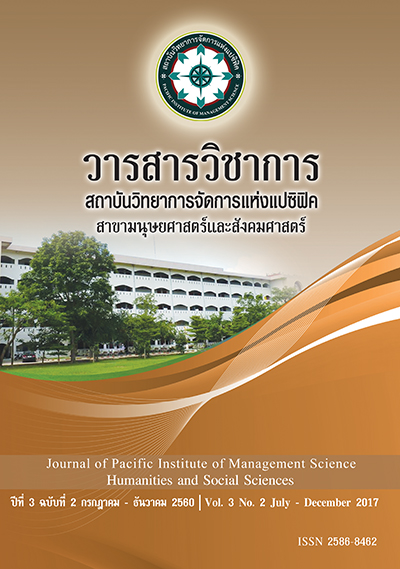Artiicial Intelligence and Industrial Revolution 4
Keywords:
Artiicial Intelligence, Industrial Revolution 4Abstract
ปัญญาประดิษฐ์ (Artiicial Intelligence : AI) คือ ศาสตร์แขนงหนึ่งทางด้านวิทยาศาสตร์และเทคโนโลยี ที่มีพื้นฐานมาจากวิชาวิทยา การคอมพิวเตอร์ ชีววิทยา จิตวิทยา ภาษาศาสตร์ คณิตศาสตร์ และวิศวกรรมศาสตร์ เป้าหมายคือ การพัฒนาระบบคอมพิวเตอร์ให้มีพฤติกรรม เลียนแบบมนุษย์ รวมทั้งเลียนแบบความเป็นอัจฉริยะของ มนุษย์ การปฏิวัติอุตสาหกรรม (Industrial Revolution) หมายถึง การเปลี่ยนแปลงวิธีการผลิตและระบบผลิตที่มี ความแตกต่างจากเดิม จากระบบการผลิตที่ทำกันภายใน ครอบครัว จึงทำให้การผลิตทำได้จำกัด และไม่เพียงพอต่อ ความต้องการ ซึ่งในอดีตนั้นนายทุนจะซื้อวัตถุดิบ แล้วนำ ไปแจกจ่ายให้กับครอบครว รับไปทำแล้วตัวพ่อค้า เองจึงมารับซื้อสินค้าที่สำเร็จรูปแล้วไปขาย ในส่วนของคนงานก็จะ ได้รับค่าจ้างตอบแทน การผลิตในรูปแบบเดิมนั้น จะต้อง ใช้แรงงานคน และแรงงานสัตว์เป็นหลัก รวมไปถึงการใช้ พลังงานจากธรรมชาติ และการใช้เครื่องมือแบบง่าย ๆ ไป จนถึงแบบที่มีความสลับซับซ้อนเพิ่มมากขึ้น จนขยายใหญ่ ขึ้นจนกลายเป็น ระบบการผลิตในระบบโรงงาน (Factory System) ซึ่งการผลิตเดิมซึ่งเป็นการผลิตภายในครอบครัว ก็ค่อย ๆ ลดความสำคัญลงไป
References
Cornell University, INSEAD, and WIPO. (2015). The Global Innovation Index 2015: Effective Innovation Policies for Development, Fontainebleau, Ithaca, and Geneva.
Deshpande, R., & Farley, J. U. (2004). Organizational culture, market orientation, innovativeness and irm performance. International Journal of Research in Marketing, 22, 3-22.
Elkington John. (2004). Enter the triple bottom line. The triple bottom line: Does it all add up, 1-16.
Gundling Ernest. (2000). The 3M Way to Innovation: Balancing People and Proit. New York: Kodansha.
Hartmann, Andreas. (2006). The Role of Organizational Culture in Motivating Innovative Behaviour in Construction Firms. Construction Innovation. 6 (3): 159-172. Retrieved March 12, 2017 from Emerald Group Publishing.
Ismail.M., Domil.A., and Isa.A. (2014). Managerial Competence, Relationship Quality and Competitive Advantage among SME Exporters. Proceedings of The 5th Indonesia International Conference on Innovation, Entrepreneurship and Small Business. Social and Behavioral Sciences 115. 138-146
James M. Higgins. (1995) “ Innovation: The core competence ” , Planning Review, Vol. 23 Issue: 6, pp.32-36, doi: 10.1108/eb054532
Julian, C.C., and Ahmed, Z.U. (2012). Factors impacting international entrepreneurship in Malaysia. Journal of Small Business and Enterprise Development, 19(2), pp.229-245.
Mahdi and Almsair.(2014). The Role of Strategic Leadership in Building Sustainable Competitive
Advantage in the Academic Environment. Procedia - Social and Behavioral Sciences 129. 289-296.
Meutia and Ismail.T. (2012).The Development of Entrepreneurial Social Competence And Business Network to Improve Competitive Advantage And Business Performance of Small Medium Sized Enterprises: A Case Study of Batik Industry In Indonesia. Proceedings of the
International Congress on Interdisciplinary Business and Social Sciences ; 2012. Social and
Behavioral Sciences. 65. 46-51.
Mo, Yan. (2008). The Relationship between Enterprise Innovation Network's Pattern and Innovation Performance. In Management of Innovation and Technology, 2008. ICMIT 2008. 4th IEEE
International Conference on 21-24 September 2008. Pp. 76-80. Retrieved March 12, 2009
from IEEE Xplore.
Teng, C., & Barrows, C. (2009). Service orientation: Antecedents, outcomes, and implications for
hospitality research and practice. Service Industries Journal, 29, 1413-1435.
Voss, G. B., & Voss, Z. G. (2000). Strategic Orientation and Firm Performance in an Artistic Environment. Journal of Marketing, 64(1), 67-83.
Downloads
Published
Issue
Section
License
บทความที่ได้รับการตีพิมพ์เป็นลิขสิทธิ์ของ สถาบันวิทยาการจัดการแห่งแปซิฟิค
ข้อความที่ปรากฏในบทความแต่ละเรื่องในวารสารวิชาการเล่มนี้เป็นความคิดเห็นส่วนตัวของผู้เขียนแต่ละท่านไม่เกี่ยวข้องกับสถาบันวิทยาการจัดการแห่งแปซิฟิค และคณาจารย์ท่านอื่นๆในสถาบันฯ แต่อย่างใด ความรับผิดชอบองค์ประกอบทั้งหมดของบทความแต่ละเรื่องเป็นของผู้เขียนแต่ละท่าน หากมีความผิดพลาดใดๆ ผู้เขียนแต่ละท่านจะรับผิดชอบบทความของตนเองแต่ผู้เดียว







